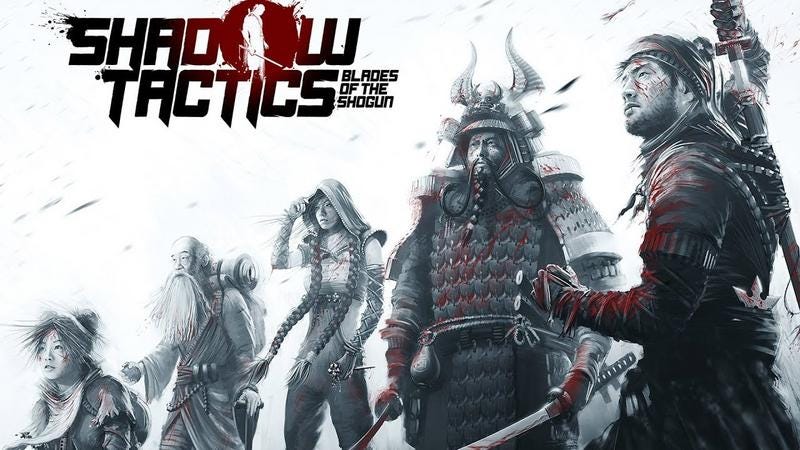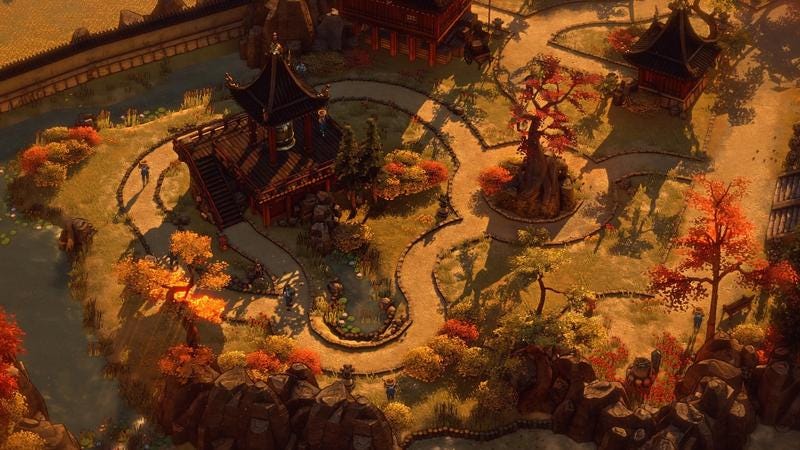Ben Plays: Shadow Tactics Blades of the Shogun
...and Commandos 2...and Desperados...
Since my early RPG experiences with Baldur's Gate and Icewind Dale, I've been a fan of the isometric perspective. One of my formative gaming memories is visiting a friend’s house and watching over his shoulder as he played Commandos. The immediate sense of scale and control was thrilling. It was one of the first games I bought when I finally owned a PC. A bird's eye view of your character's wider environment creates the illusion of an expansive game world, while simultaneously positioning your character as but a tiny piece within it. Distance allows for more persuasive graphics since close up textures need not be drawn in high detail, and creates the potential for advanced strategy and planning. Shadow Tactics: Blades of the Shogun exploits all of these advantages for its real time stealth gameplay in a meticulous and mentally fatiguing gauntlet through Edo period Japan.
Broadly, the plot details a Shogun’s efforts to maintain peace and stability across Japan as his rule is challenged by a mysterious would-be usurper known only as Kage-sama. The opening (tutorial) level sees you step into the silent shoes of Hayato, a ninja, during an assault on a fortress where the basic mechanics of the game are introduced - point, click and avoid enemy line of sight. With his grappling hook and trusty throwing arm, Hayato slips unnoticed from shrubbery to rooftop leaving carefully concealed corpses in his wake. But just as Bill Murray is beaten to the train by Adrien Brody at the start of The Darjeeling Limited, you soon realise, as he does, that Hayato is not the real protagonist of this story. Instead, on the battlefield, he meets Oshiro Mugen, samurai, loyal servant to the Shogun, and soon to be leader of a motley gang of shadowy tacticians. It’s your job, under the command of Mugen, to mitigate Kage-sama’s malevolent plans and ultimately unmask and end him. Doing so will require drawing on the unique talents of five playable characters through thirteen scrupulously laid out maps, in snowy mountains, humid jungle, rice fields, military encampments, bathhouses, prisons and castles.
In the words of Liam Neeson, each character has a very particular set of skills. Mugen is less Neeson and more ‘The Rock’ Johnson: the strong man of the group. He’s the guy you’ll have tossing boulders and barrels, and he’ll throw a few corpses over his shoulders and sprint without breaking a sweat. Hayato is your generic Shuriken wielding shinobi, then there’s Yuki, a roguish girl with trap and luring bird call; Aiko, a beguiling ‘Kunoichi’ (female ninja) who favours the art of disguise; and Takuma, a geriatric sharpshooter. In many ways, these are all pretty familiar roles: the tank, the rogue, the spy… firmly established genre stereotypes that, truthfully, Shadow Tactics doesn’t do a lot to reinvent. But why bother when they work and complement each other so well? The stats at the end of each mission highlight how successful the developers have been in dividing up the responsibilities of these characters. It wasn't unusual for me to complete a level with a near even split of time spent between them, though almost always it was the stealthiest of characters who had the upper hand - sorry, Mugen, ya Heffalump!
Admittedly, some of the game mechanics could do with a bit more honing to work thematically. For instance, Hayato can throw a stone to distract and draw the attention of guards, but why is this ability unique to him? Surely even the clumsiest and most inept of character classes can muster the skill to find and toss a stone? Likewise, Aiko carries a pouch of sneezing powder which will briefly blind her victim, but couldn't each character wield such a pouch? Other skills feel personal and specific to each character, so it's a shame these exceptions sneak through the gaps. Yuko is a child, and therefore struggles to hide a body quickly and Mugen wears bulky samurai armour so can't run fast. Takuma is injured at the beginning of the game so hobbles on a noisy false leg, but it's that leg that transforms into his long ranged rifle, and his tame pet Kuma, a 'tanuki' (read: racoon) is invaluable at drawing attention. These quirks are colourful and really bring the cast to life. In fact, given how little dialogue there is in the game, it's surprising how quickly the characters win you over with their jovial banter, and their pithy catchphrases, a staple of the genre, are memorable and don't wear thin too easily. (“Into battle! Time for action! This used to be easier!”) While there are cut scenes between levels for the purpose of scene setting and plot development, they are sparse and protracted comparative to the in-mission dialogue between your team members. As it should be: the real action happens on the job.
The maps are sometimes dauntingly large, filled with hostile forces and suspicious eyes, and your enemies are not all as hapless and easily led astray as the average guard: ‘Straw hats’ are resistant to lures and distractions, and Samurai see through disguises and resist single handed attacks by anyone except Mugen. I was prepared to list a myriad of enemy types here, but I’m realising it really is just those three! The game mixes and matches them in vexingly lethal ways so their threat never gets old. Particularly challenging are the multitude of heavily fortified choke points (usually bridges or gateways) you'll need to surpass in order to reach your objective. Fortunately, you have plenty of options. Whether discretely sneaking aboard a wagon, swimming a river, tightrope walking between rooftops, or shortcutting through tunnels, your target is always closer than you think. In much the same way as the Hitman franchise offers a multitude of ways to dispatch your enemy, Shadow Tactics allows for a diverse range of approaches, and usually offers rewards in the forms of 'badges' (read: achievements) for being inventive or achieving something especially challenging (like avoiding killing any guards, or never hiding in a bush). Using the environment is also a joy - detaching hanging icicles, provoking irascible oxen or dislodging precariously placed boulders, though I would have liked even more opportunity to get creative.
To keep you on your toes, the game dynamics are often shifted in pleasing ways. For example, civilians, who are normally ready to dob you in to the nearest guard, will hold their tongues to aid and abet you if their overlords are treating them poorly. Footprints in the snow will lead a suspicious, eagle-eyed goon right to you, but that creates opportunities for ambush. Similarly, while an enemy's field of view is usually a straightforward cone, solid at short range and striped at a distance to indicate their ability to spot you, at night, this mechanic gets a good shake up, with the view cone shorter overall and the bright area much smaller, allowing you to exploit the shadows. Of course, the flip side of this apparent advantage is that light sources turn everywhere nearby into highly visible areas with nowhere to hide, so figuring out how and when to snuff them out is critical.
While I personally wouldn't play through multiple times, hardcore fans will certainly find replayability in concocting plans to reach their goals elegantly while whittling down their time to hit one of the 'speedrun' benchmarks. (I would honestly consider these impossible targets, usually around a fifth or less of my level completion time, if it weren’t for the numerous YouTubers demolishing them. It’s possible I am particularly crap, but one late game mission took me more than three and a half hours to complete. The speedrun benchmark was 9 minutes.) Playing on normal difficulty is still savagely unforgiving, and demands regular quicksaving. But it’s exactly this complexity that makes it so rewarding. I often spent tens of minutes pondering and repeatedly trying strategies to traverse a single area, each time adjusting and tweaking, each time my masterplan torn asunder by a forgotten patrol or a guard with 20/20 vision. When first presented with a scene where it seems every enemy is watched by at least two other enemies and there are no apparent blind spots, the sense of accomplishment when you finally pull apart the knot of eyes is enough to make you jump from your chair and punch the air. From putting an entire camp to sleep by poisoning their Sake to kidnapping a VIP from a geothermal spa, every level contains the thrill of a ‘mission: impossible’, if only you can decrypt the puzzle. I don’t think I’ll ever forget synchronising simultaneous executions on samurai while scaling the tiers of a pagoda to assassinate a ruler on his balcony, nor do I regret reloading the level to drown him by throwing him off the roof instead of the vanilla knifing I initially delivered to his back. Shadow Tactics: Blades of the Shogun may only boast thirteen levels, but it’s a game with hundreds of golden, memorable moments, and a game I highly recommend. I’m now nervously excited at the prospect of playing Mimimi Productions’ Wild West follow up: Desperados 3.


